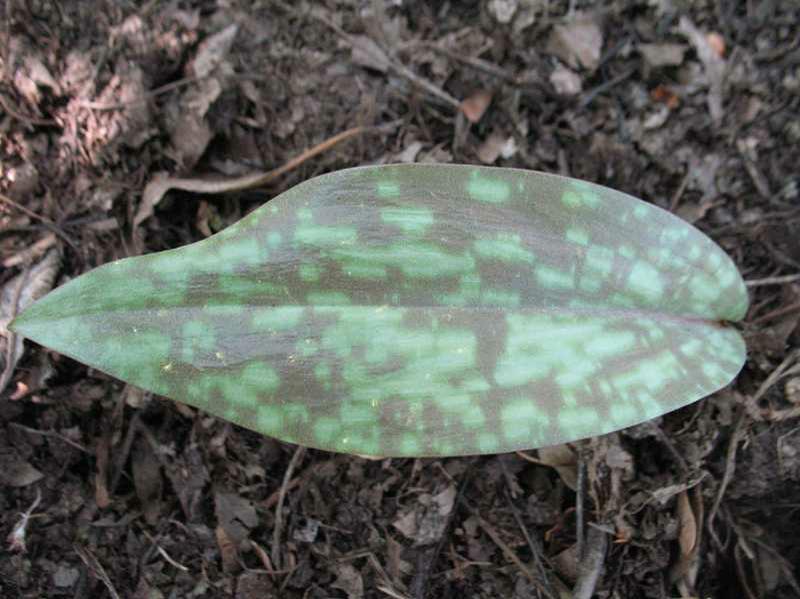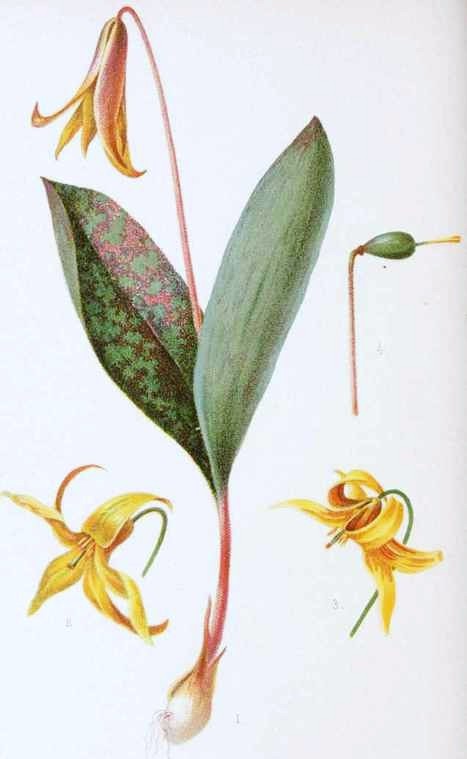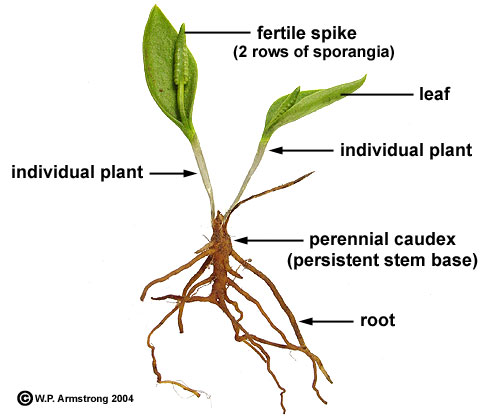While doing some research on Addler’s Tongue, of which I was reading about in a book of Native American Plants & Medicine, I discovered that there is a difference, as well as, some similarities in two different plants that are very close in spelling. The Addler’s Tongue and the Adder’s Tongue. While they have very similar uses, one is considered a fern plant and one is considered to be a lily. So I decided to talk about them both. I feel that when working with wild or garden grown plants for medicinal use, especially those with similar names, it is of the utmost importance to research and know what plants you are using…
I will start with the Adder’s Tongue.
By Ivy Main – Own work, CC BY-SA 3.0, Link
The Adder’s Tongue — Erythronium americanum,
Commonly called yellow adder’s tongue, yellow trout lily, yellow fawn lily and yellow dog-tooth violet. Other Names: Serpent’s Tongue, Yellow Adder’s-tongue, Yellow fawn-lily, Yellow Snowdrop
It is a spring wildflower that occurs in moist woods, on wooded slopes and bluffs, and along streams.
A single, nodding, bell- or lily-shaped yellow flower blooms atop a naked scape sheathed by two glossy, tongue-shaped, tulip-like, basal leaves (to 6” long) in early spring. Petal-like perianth segments are reflexed and often brushed with purple on the outside. Anthers are yellow to brown. Leaves are mottled with brown and purple. It typically grows 4-6” (infrequently to 9”) tall. Flowering plants always have two basal leaves, however colonies frequently have non-flowering plants with only a single leaf.
The common name of adder’s tongue is in reference to the tongue-like shape of the flowering shoot as it rises up in spring and the supposed resemblance of the flower to the open mouth of a snake. The common name of trout lily is in reference to the mottled leaves and the appearance of the flowers during trout fishing season.
The common name of fawn lily is in reference to the spotted leaves and the supposed resemblance of the two-leaved plant to the upright ears of a fawn.
The common name of dog-tooth violet (it grows from tiny corms that purportedly resemble dogteeth and its flowers somewhat resemble violets) is unfortunately quite misleading because this flower is not a member of the violet family.
Trout Lily is the herald of spring in eastern woodlands, but this native wildflower also makes a gorgeous addition to any shade garden in zones 3-8. The plant’s name comes from its speckled green leaves (that resemble trout), and its nodding yellow flowers that look like miniature lilies. Plants can take up to four years to flower after planting. In most populations, non-flowering individuals outnumber the flowering ones.
Yellow trout-lily is a long-lived perennial that grows from a deep-seated corm, which gets larger and goes deeper into the soil the older it gets, sometimes eventually going down over a foot. The species is highly colonial, spreading not only by seeds but also by offshoot runners from the corms and forming extensive, forest-carpeting clones. Such colonies were found to be as old as 1300 years, averaging nearly 150 years in age, in one study. Until the corm reaches flowering size (is fertile), it produces only a single, ground-level leaf per season. Fertile corms produce a pair of essentially basal leaves. Most plants in any given colony are single-leaved, not yet fertile. 
The relatively large flowers track the sun and close at night. The six stamens may be yellow or red, and the 3-parted, club-shaped pistil matures into a many-seeded capsule. The flowers are insect-pollinated, and the seeds are furnished with fat bodies called elaiosomes, which indicate dispersal by ants.
Yellow trout-lily is a charming spring bloomer in is normally grown in partly shaded rock or woodland gardens and informal corners in the landscape. It can be propagated from seeds or offsets (new corms on underground runners) in deep, loose, relatively moist soil that is rich in organic matter. A winter mulch of peat or leaf litter is recommended. The seeds may not germinate until the second spring after ripening.
The main threat to this still relatively common native species is habitat destruction.
The common name dogtooth violet is a reference to the appearance of the corms which resemble dog teeth. However, this is not a violet but rather a lily. Deer may find the leaves of this plant to be an irresistible early spring treat.

The following information I found on a very interesting survival blog by ToddWalker. There is also a very interesting video on his site related to foraging and roasting trout lily bulbs. https://survivalsherpa.wordpress.com/2014/03/18/foraging-feral-food-trout-lily/
Flower: The yellow Trout lily produces a single, nodding flower with six pedals. The flower closes at night and opens in the day light. The flower has both male and female sex organs.
Leaves: This perennial produces one to two lance-shaped leaves. A one leaf plant has not yet matured. Give it a year or seven. The stem of the plant is brownish-red.
Crom/bulb: The mature bulb resembles a dog’s canine tooth and is covered with a brown paper-like skin. Peel the skin before eating raw.
Trout Lily or Adder’s Tongue has been used in alternative medicine, as well as Native American medicine, as a contraceptive, diuretic, emetic, emollient, febrifuge, stimulant. The leaves and bulb are crushed and used to dress wounds and reduce swellings, for scrofula and other skin problems. A medicinal tea made from the root and leaf is said to reduce fever and fainting, tea also taken for ulcers, tumors and swollen glands.
This Plant is also an emetic meaning Caution! …Trout Lily can be strongly emetic (which means if you take in too much…..it can make you throw up a lot)!
Medicinal Uses
- Native American women ate raw leaves to prevent conception
- Root tea to reduce fever
- Poultice from the crom is used to draw splinters and reduce swelling
- Leave poultice is used on hard to heal ulcers and skin conditions
- Fresh or dried leaves soften skin – always test for allergic reaction on a small area of your skin
- From the early to mid Nineteenth century the plant was used to treat gout
Edible Uses
- The flower, leaves, and bulb are edible.
- Mass quantities will cause you to throw up – take it easy on them, unless you need to vomit.
- Crom/bulb can be roasted – raw they have a cucumber taste.
- Flowers are slightly sweet due to their nectar.
- Leaf tea
- Ground croms can be used as a thickening agent for cooking.
I have included this video because you will be able to see the mottling and the bulbs very well. You will see why this mottling on the leaves will help you in identifying the difference between Adder’s Tongue and Addler’s Tongue when you go looking for them in the wild.
Now Let’s Talk About Addler’s Tongue
Addler’s Tongue – Ophioglossum_vulgatum

By Orchi – Self-photographed, CC BY-SA 3.0, Link
Often confused with Adder’s Tongue……..Addler’s Tongue is of the fern family, and has been considered as an herb by many Native Americans.
Ophioglossum vulgatum, commonly known as addler’s-tongue, southern addlers-tongue or addlers-tongue fern, is a species of fern in the family Ophioglossaceae.
Ophioglossum vulgatum grows from a rhizome base. It consists of a two-part frond, separated into a rounded diamond-shaped sheath and narrow spore-bearing spike. The spike has around 10-40 segments on each side. It reproduces by means of spores. It can grow as tall as 9 ft in height.

The roots and the herb are both used for medicinal purposes. It is a popular remedy for healing wounds, including burns, cuts, insect bites, bruises and abrasions. Native American’s often mixed the juice of the Addler’s Tongue with beeswax to make a salve. It is also known as a pain reliever when used for sciatica and neuralgia. This can be achieved by soaking a cloth in the herb’s extract and placed as a topical on the affected area several times a day.
Addler’s Tongue can also be made into a tea and used to break up mucus and congestion suffered by asthma and bronchitis patients. Traditional European folk also used leaves and rhizomes as a poultice for wounds. This remedy was sometimes called the “Green Oil of Charity”. A tea made from the leaves was used as a traditional European folk remedy for internal bleeding and vomiting.
Another reference I have quoted in italics below:
http://www.innerpath.com.au/matmed/herbs/Ophioglossum_vulgatum.htm
Ophioglossum vulgatum. Ophioglossum vulgatum. Addler’s tongue Family: Ophioglossaceae
PART USED: Leaves
ACTIONS
1. Emetic, emollient.[1]
2. The fresh leaves are used as a poultice for ulcers, together with an infusion taken internally.[1]
3. The aquious extract has antibacterial action.[1]
INDICATIONS
Wounds- An ointment has been make by boiling the herb in oil of fat.[1]
ORIGIN: Europe, including Britain, from Iceland south and east to N. Africa, north and west Asia.
References
[1] Potter’s New Cyclopaedia of Botanical Drugs and Preparations R.C. Wren Revised by Elizabeth M. Williamson and Fred J Evans. First published in Great Britain in 1988 and reprinted in 1989 and 1994 by the C. W. Daniel Company Limited. 1 Church Path, Saffron Walden Essex. Published 1988 Printed and bound by Biddles, Guildford ISBN 085207 1973.
So as you can see both plants are said to have an emetic affect and both plants have been used for healing skin and wounds…… But they Are NOT the same plant, nor are they even in the same family species of plants.
I cannot stress enough the importance of researching and learning to identify your plants before foraging, growing in your garden and especially in using them for food or medicinal use.
I have including the following video because it has some great photographs of Ophioglossum vulgatum plants or Addler’s Tongue. It is basically a slide-show set to music.
I hope you have learned something from this post, as I know I did while researching it. It is so important to learn the differences and identifying factors when working with wild plants. There are so many that are similar in appearance as well as in use. I hope that this post will help you identify them easier. I have actually seen both of these plants growing wild in my yard. So take a walk and see if you can find them. Until next time,
Blessed Be.
Grim
Resource Links:
https://creativecommons.org/licenses/by-sa/3.0/
http://www.missouribotanicalgarden.org/PlantFinder/PlantFinderDetails.aspx?kempercode=a748
https://plants.usda.gov/core/profile?symbol=eram5
https://www.americanmeadows.com/perennials/woodland-wildflowers/trout-lily
https://gobotany.newenglandwild.org/species/erythronium/albidum/
http://vnps.org/wildflowers-of-the-year/2003-yellow-trout-lily-erythronium-americanum/
https://www.izelplants.com/erythronium-americanum-dogtooth-violet.html
https://altnature.com/gallery/troutlily.htm
https://survivalsherpa.wordpress.com/2014/03/18/foraging-feral-food-trout-lily/
https://en.wikipedia.org/wiki/Ophioglossum_vulgatum
https://plants.usda.gov/core/profile?symbol=OPVU&mapType=nativity
http://www.innerpath.com.au/matmed/herbs/Ophioglossum_vulgatum.htm
Secrets of The Sacred White Buffalo Gary Null Phd. 1998 by Prentice Hall Inc. Prentice Hall Press, Parmus NJ.
Reader’s Digest Magic and Medicine of Plants, The Reader’s Digest Association 1986.

thank you I added the link to the resources, I appreciate you pointing it out, I try very hard to save all the sites I borrow from or reference . 🙂
LikeLike